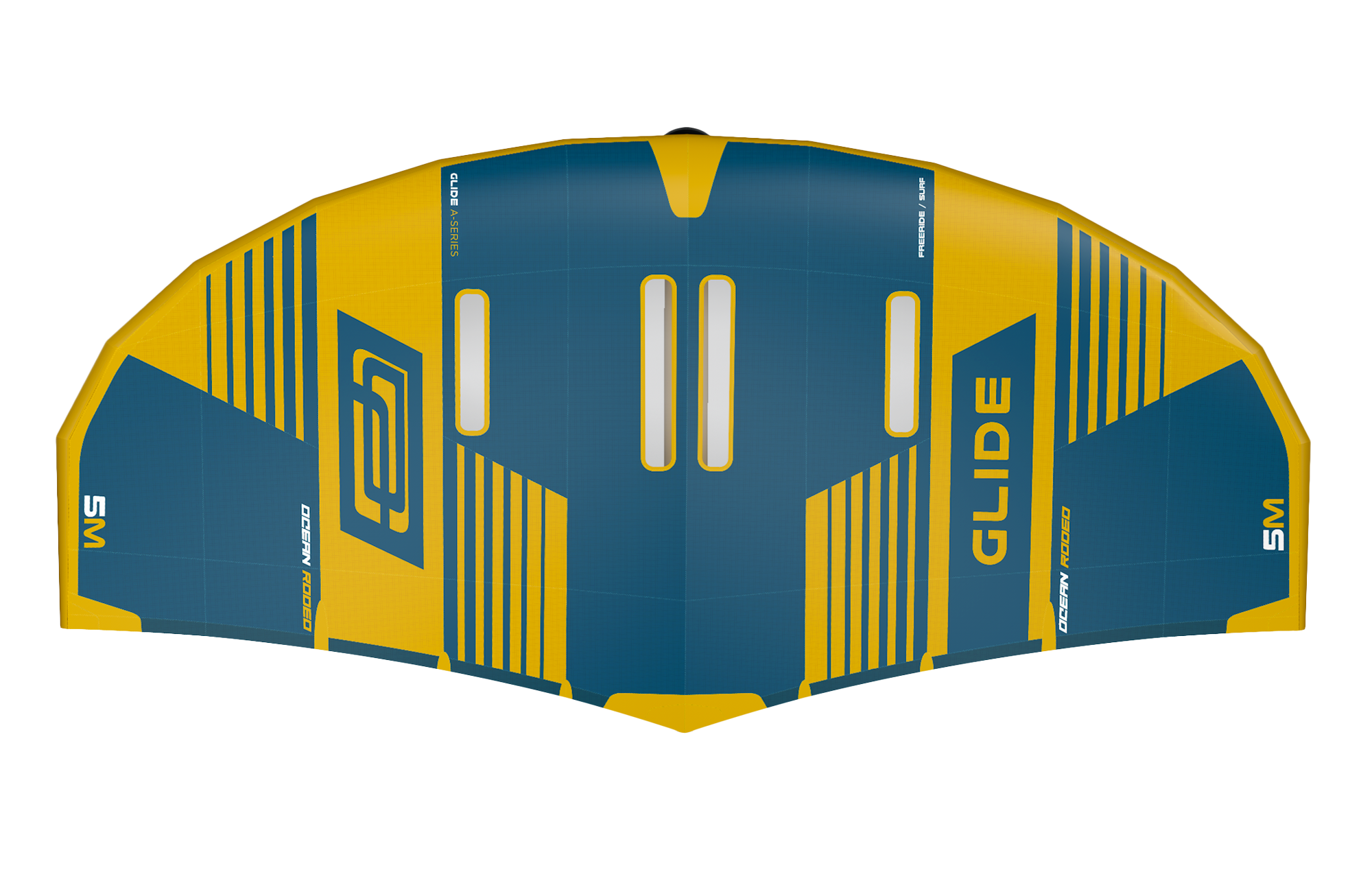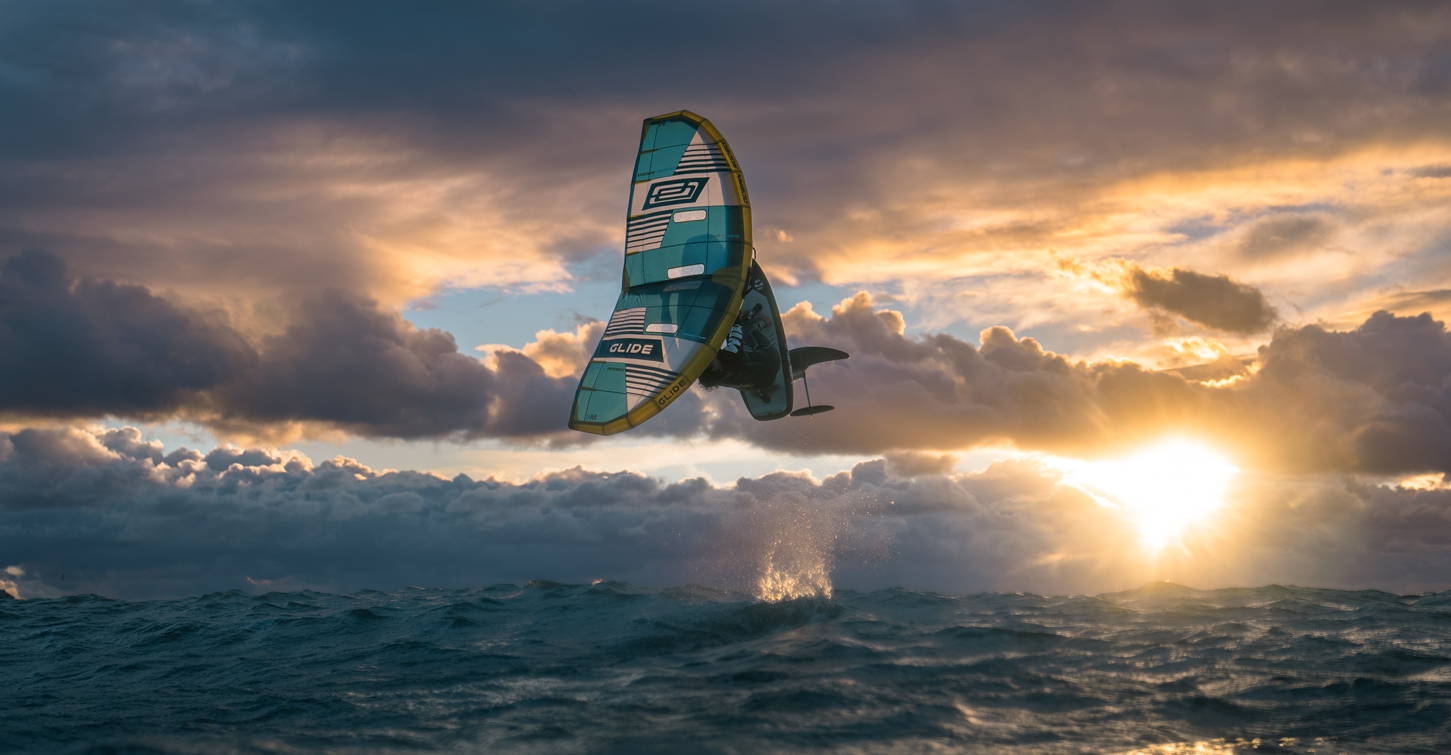
PART TWO
THE WINGFOIL RACING BLUEPRINT
At only 20 years of age, Mathis has reached incredible heights already in the world of Wingfoil racing. In the second part of the series, Mathis takes us through his personal aspirations for the future and shares what it takes if you are keen to up your wingfoiling game. He also gives us an insight into some of the exciting innovations coming up next from Ocean Rodeo.

> We hear you're using a special bladder from ALUULA on your struts...what is the difference you’ve noticed?
Since using the ALUULA bladder on my strut, I’ve felt the strut has been much stiffer, which puts more power into my hands. The strut also doesn’t twist when I use harness lines and I’m pulling with all of my weight to accelerate. This is a huge plus when it comes to pumping efficiency.
> You've been testing some early ALUULA canopy. What's your thoughts in terms of speed if the canopy can be made stiffer?
Yes, the new canopy is insanely strong and stiff. I was feeling much more power from the 5m that I tested, and the pumping is now even more efficient. Having a stiffer canopy results in having more power for a wing of the same size. It also allows me to reduce the wing size and so to reduce the leading edge and the drag from that. It directly results in higher speeds and faster acceleration due to less stretch from the canopy. It also helps to avoid the distortions of the canopy created by the wind speed, so it will reduce drag with a cleaner wing profile.
> In terms of use and performance, what do you expect will be the biggest improvements made to winging with new canopy materials, in terms of racing and general all-round wingfoiling?
In my opinion, this will be the new arms race in the coming years, for all the brands to find an efficient canopy material, as it was two years ago for the leading edge and strut materials. So many different materials are already out, but yet again, I’m convinced that ALUULA material for the canopy will be another revolution and the ultimate leader when it comes to stiffness, power, lightness and durability.
For racing, new canopy materials with much more stiffness, and thus power, are gonna help to reduce the wing size, and so lead to slimmer leading edge profiles to reduce drag and to increase the speed. For winging overall, I think that we’ll be able to fly in lighter conditions, to reduce and maybe eliminate the current situation with standard wings where it is possible to fly but impossible to take off in light wind conditions.
> When did you start winging? Is it easy for everyone to learn and progress in it?
I started winging in October 2020, so less than three years ago. In terms of learning, I’ve seen plenty of different beginner profiles - I’ve seen some friends who have never practiced a water sport in their life able to make their first wing flight after a week of lessons. Having the right equipment helps a lot at the beginning for sure, but when they are well equipped, their giant smile at the end of the session speaks for itself.
Wingfoiling is much safer to learn than kitesurfing because you’ll never be in danger while learning. If you’re drifting too much, you lay on your board, paddle upwind and then you’re out of danger. Winging is also easier to learn than windsurfing, because the sail is so much lighter, so you won’t struggle to get it out of the water every time you fail.
> What would be your main advice for anyone just starting out on a wing?
My main advice for wingfoil beginners is to start with some tow in and learn how to fall properly. You have to always let yourself fall in the direction of the board, and not counter the foil by leaning in its opposite direction because this will result in you kissing your frontwing…
> Do you think there's an ideal body size for wing racing?
For the moment, there is not an ideal body in winging, but there are some advantages to being tall, because it is possible to put the wing in front and so to capture the maximum amount of wind, and around 80-85kg to press down on the foil efficiently. The only factors which are limiting this weight are the lift and power differences that exist between kites and the wing. In the meantime, being heavier than 85kg in winging would mean having to make big equipment choices because the foil size would not be the same in light, normal, and strong wind conditions. The foil choices would be so hard to decide and to make, except if a coach is on the water and able to change the foil quickly for you. I’m convinced that in the near future we’ll see the same body sizes in winging as we do in windsurf and kitefoil.
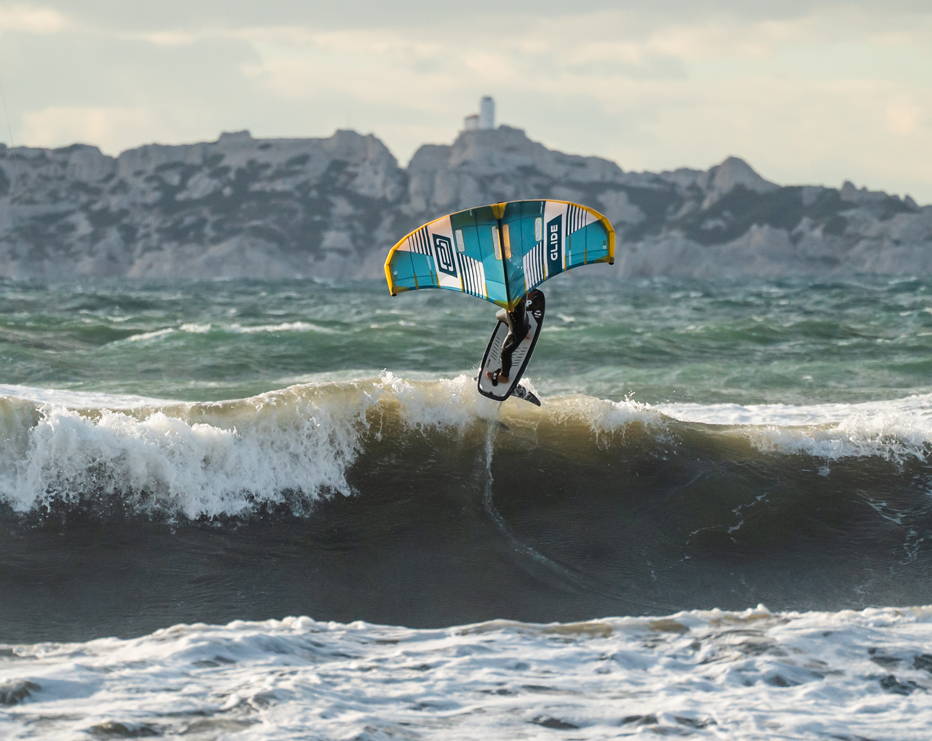
> Is it hard to transition from riding in waves to racing?
The transition is always so hard for me because I don’t experience the same level of adrenaline and stress. While racing, I’m used to this feeling of speed and stress before starting, but for riding waves, I’m still discovering how to handle it. When there are a lot of waves, I cannot wait and I want to jump in the water instantly to enjoy the swell, because I know that I’ll have a ton of fun while riding the waves. This feeling is present for me in the racing discipline but in a softer way, because I love to be fast and compete with my friends to see who will be the fastest. But I’m able to handle my excitement because I’m so used to it, whereas riding waves is still something I do less frequently.
> What’s your physical training like off the water?
I’m in Lyon five days a week for my studies and I can not wingfoil there, so to blow off some steam, I train almost everyday at the gym. I usually do a lot of cardio and practice weightlifting, targeting my forearms and legs since they're the most used muscles during races.
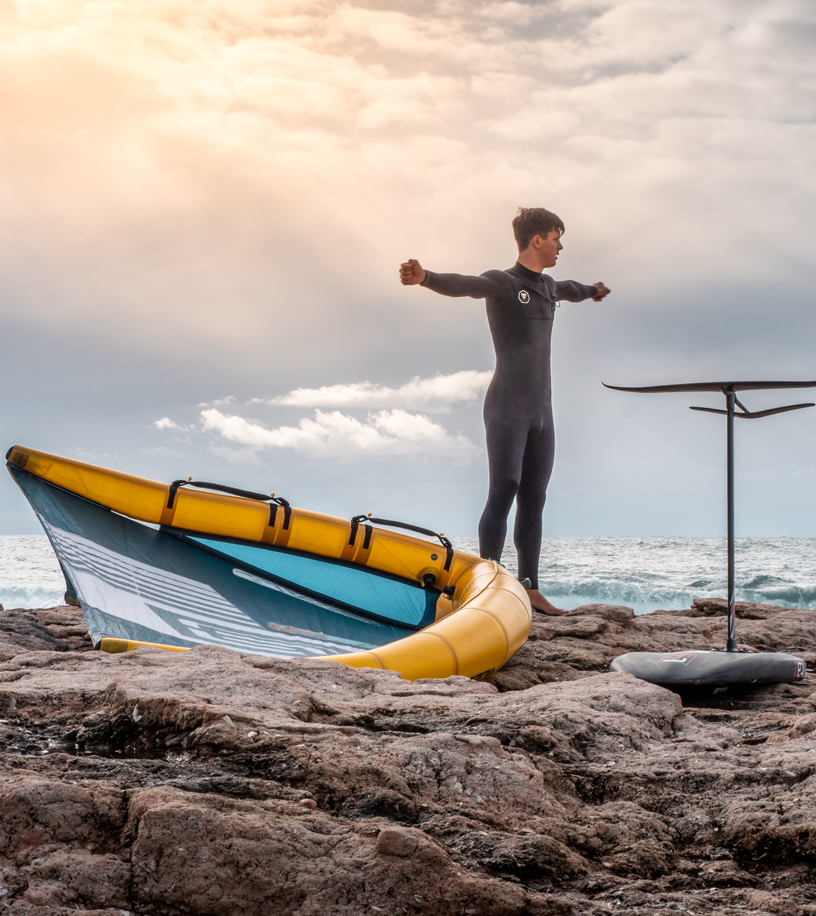
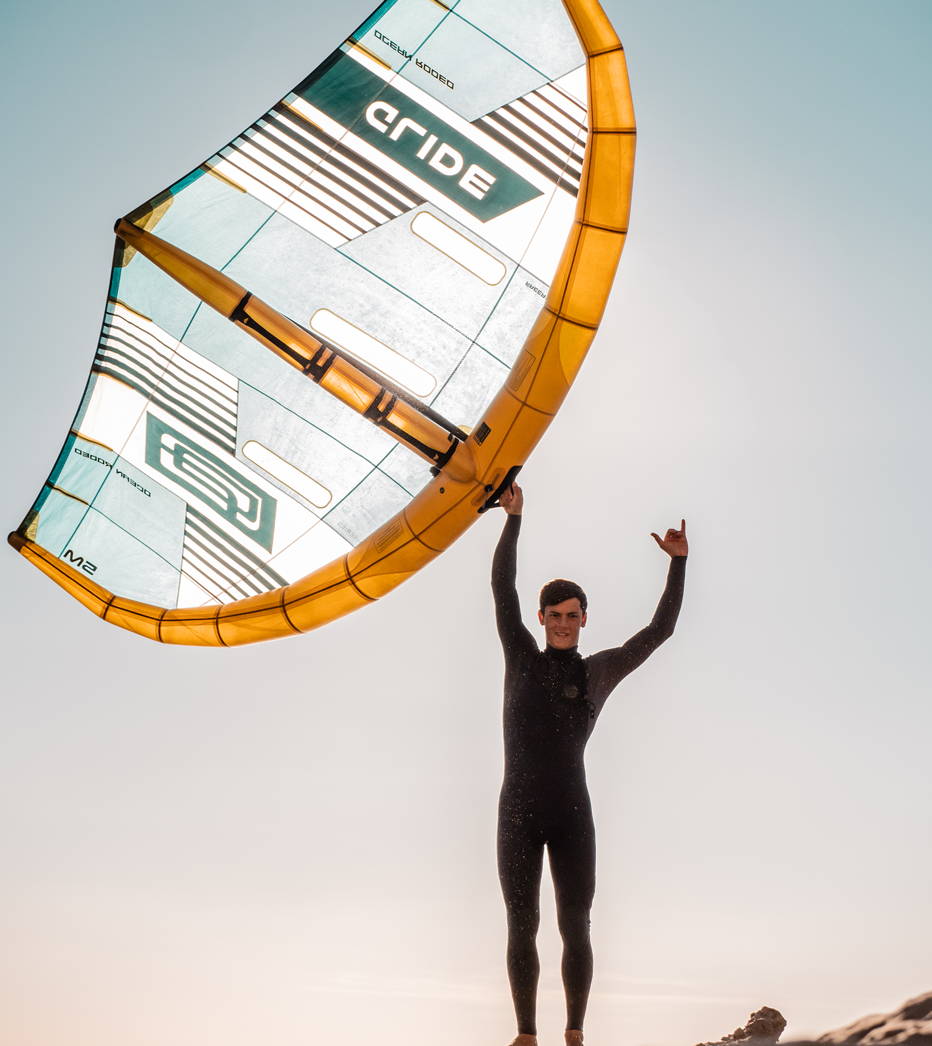
> How do you prepare before a race start?
I’m the type of person who has a lot of set rituals to destress before racing. I always go out on the water with my camel bag, to take sips of water between my warm-ups. I begin my analysis with an overall view of the competition area by taking in the surrounding coasts, the wind effects and how the start line is set. Then, I’ll choose a side area that seems interesting for the coming race, and I’ll scope it out by going on this side in a straight line towards the area.
If the buoys are already set, I’ll round them to identify the points of sail at the same time. Then, on my way back to the committee boat, I’ll pump exactly like I’ll be in a race, while making a lot of manoeuvers to work on my balance and to prepare my legs for the upcoming race. When I arrive at the committee boat, I take one or two sips of water before giving my camel bag to my coach, and often screw one or two screws of my foil if needed. Then, I dry my wing by pumping a little bit and staying on the foil before the race starts.
> What’s been your favourite race so far?
My favourite race event was definitely the Jericoacoara World Cup last December.The vibes and the conditions were incredible throughout the whole event, and winning the World Cup and the World Title was the icing on the cake.
> What are your goals for 2023 and beyond?
I have two main goals to achieve this year which are winning the ANOC World Beach Games in Bali, Indonesia and winning the World Title for the second year in a row by winning as many World Cups as I’m capable of.
> How do you see the sport/discipline of wing foil racing progressing/changing as it continues to develop?
I’m convinced we’ll see a lot of innovations around wing designs and shapes. I also think that the boom will become our weapon of choice when it comes to racing handles. Then the Medal Series format from the IWSA is really captivating and fun. I think it’ll attract more and more viewers as it is interesting for the public to have a final day where “everything” is possible, while remaining fair to the athletes for their hard work during the previous competition days. I hope that wingfoiling will become an Olympic sport in 2028, and if it is not - due to the five year registration period - I’m convinced it’ll go to the Olympics in 2032.
At only 20 years of age, Mathis has reached incredible heights already in the world of Wingfoil racing. In the second part of the series, Mathis takes us through his personal aspirations for the future and shares what it takes if you are keen to up your wingfoiling game.
He also gives us an insight into some of the exciting innovations coming up next from Ocean Rodeo.
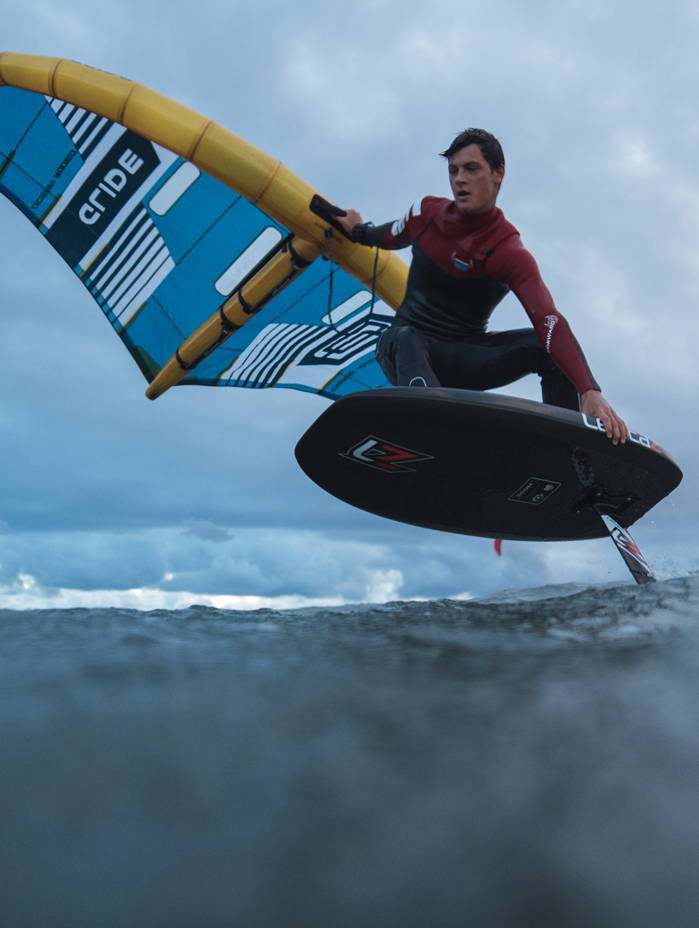
> We hear you're using a special bladder from ALUULA on your struts...what is the difference you’ve noticed?
Since using the ALUULA bladder on my strut, I’ve felt the strut has been much stiffer, which puts more power into my hands. The strut also doesn’t twist when I use harness lines and I’m pulling with all of my weight to accelerate. This is a huge plus when it comes to pumping efficiency.
> You've been testing some early ALUULA canopy. What's your thoughts in terms of speed if the canopy can be made stiffer?
Yes, the new canopy is insanely strong and stiff. I was feeling much more power from the 5m that I tested, and the pumping is now even more efficient. Having a stiffer canopy results in having more power for a wing of the same size.
It also allows me to reduce the wing size and so to reduce the leading edge and the drag from that. It directly results in higher speeds and faster acceleration due to less stretch from the canopy. It also helps to avoid the distortions of the canopy created by the wind speed, so it will reduce drag with a cleaner wing profile.
> In terms of use and performance, what do you expect will be the biggest improvements made to winging with new canopy materials, in terms of racing and general all-round wingfoiling?
In my opinion, this will be the new arms race in the coming years, for all the brands to find an efficient canopy material, as it was two years ago for the leading edge and strut materials. So many different materials are already out, but yet again, I’m convinced that ALUULA material for the canopy will be another revolution and the ultimate leader when it comes to stiffness, power, lightness and durability.
For racing, new canopy materials with much more stiffness, and thus power, are gonna help to reduce the wing size, and so lead to slimmer leading edge profiles to reduce drag and to increase the speed. For winging overall, I think that we’ll be able to fly in lighter conditions, to reduce and maybe eliminate the current situation with standard wings where it is possible to fly but impossible to take off in light wind conditions.
> When did you start winging? Is it easy for everyone to learn and progress in it?
I started winging in October 2020, so less than three years ago. In terms of learning, I’ve seen plenty of different beginner profiles - I’ve seen some friends who have never practiced a water sport in their life able to make their first wing flight after a week of lessons. Having the right equipment helps a lot at the beginning for sure, but when they are well equipped, their giant smile at the end of the session speaks for itself. Wingfoiling is much safer to learn than kitesurfing because you’ll never be in danger while learning. If you’re drifting too much, you lay on your board, paddle upwind and then you’re out of danger. Winging is also easier to learn than windsurfing, because the sail is so much lighter, so you won’t struggle to get it out of the water every time you fail.
> What would be your main advice for anyone just starting out on a wing?
My main advice for wingfoil beginners is to start with some tow in and learn how to fall properly. You have to always let yourself fall in the direction of the board, and not counter the foil by leaning in its opposite direction because this will result in you kissing your frontwing…
> Do you think there's an ideal body size for wing racing?
For the moment, there is not an ideal body in winging, but there are some advantages to being tall, because it is possible to put the wing in front and so to capture the maximum amount of wind, and around 80-85kg to press down on the foil efficiently. The only factors which are limiting this weight are the lift and power differences that exist between kites and the wing. In the meantime, being heavier than 85kg in winging would mean having to make big equipment choices because the foil size would not be the same in light, normal, and strong wind conditions. The foil choices would be so hard to decide and to make, except if a coach is on the water and able to change the foil quickly for you. I’m convinced that in the near future we’ll see the same body sizes in winging as we do in windsurf and kitefoil.
> Is it hard to transition from riding in waves to racing?
The transition is always so hard for me because I don’t experience the same level of adrenaline and stress. While racing, I’m used to this feeling of speed and stress before starting, but for riding waves, I’m still discovering how to handle it. When there are a lot of waves, I cannot wait and I want to jump in the water instantly to enjoy the swell, because I know that I’ll have a ton of fun while riding the waves.
This feeling is present for me in the racing discipline but in a softer way, because I love to be fast and compete with my friends to see who will be the fastest. But I’m able to handle my excitement because I’m so used to it, whereas riding waves is still something I do less frequently.
> What’s your physical training like off the water?
I’m in Lyon five days a week for my studies and I can not wingfoil there, so to blow off some steam, I train almost everyday at the gym. I usually do a lot of cardio and practice weightlifting, targeting my forearms and legs since they're the most used muscles during races.
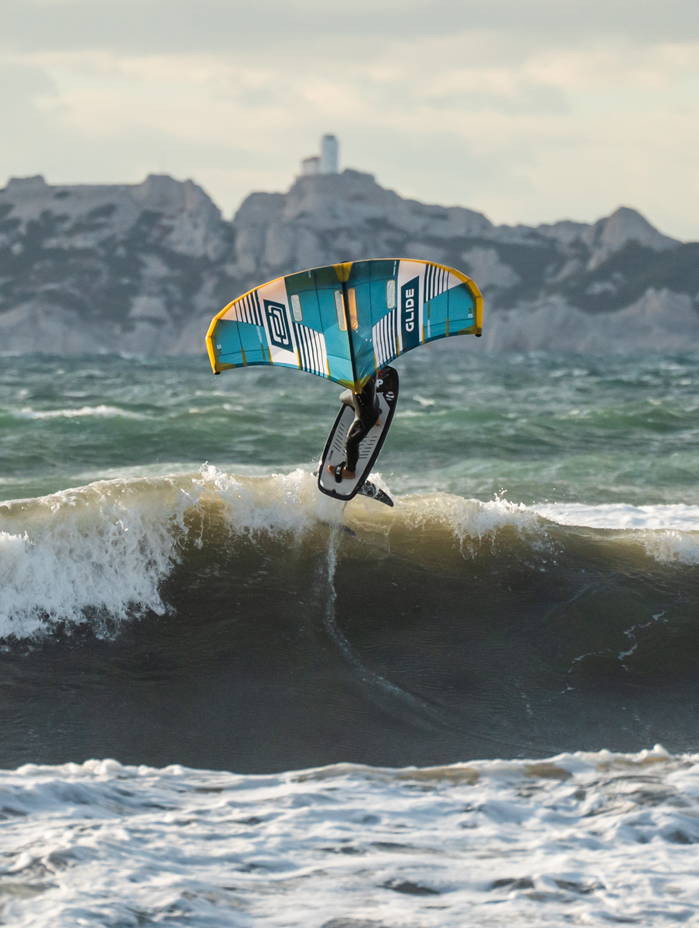
> How do you prepare before a race start?
I’m the type of person who has a lot of set rituals to destress before racing. I always go out on the water with my camel bag, to take sips of water between my warm-ups. I begin my analysis with an overall view of the competition area by taking in the surrounding coasts, the wind effects and how the start line is set. Then, I’ll choose a side area that seems interesting for the coming race, and I’ll scope it out by going on this side in a straight line towards the area. If the buoys are already set, I’ll round them to identify the points of sail at the same time. Then, on my way back to the committee boat, I’ll pump exactly like I’ll be in a race, while making a lot of manoeuvers to work on my balance and to prepare my legs for the upcoming race. When I arrive at the committee boat, I take one or two sips of water before giving my camel bag to my coach, and often screw one or two screws of my foil if needed. Then, I dry my wing by pumping a little bit and staying on the foil before the race starts.
> What’s been your favourite race so far?
My favourite race event was definitely the Jericoacoara World Cup last December.The vibes and the conditions were incredible throughout the whole event, and winning the World Cup and the World Title was the icing on the cake.

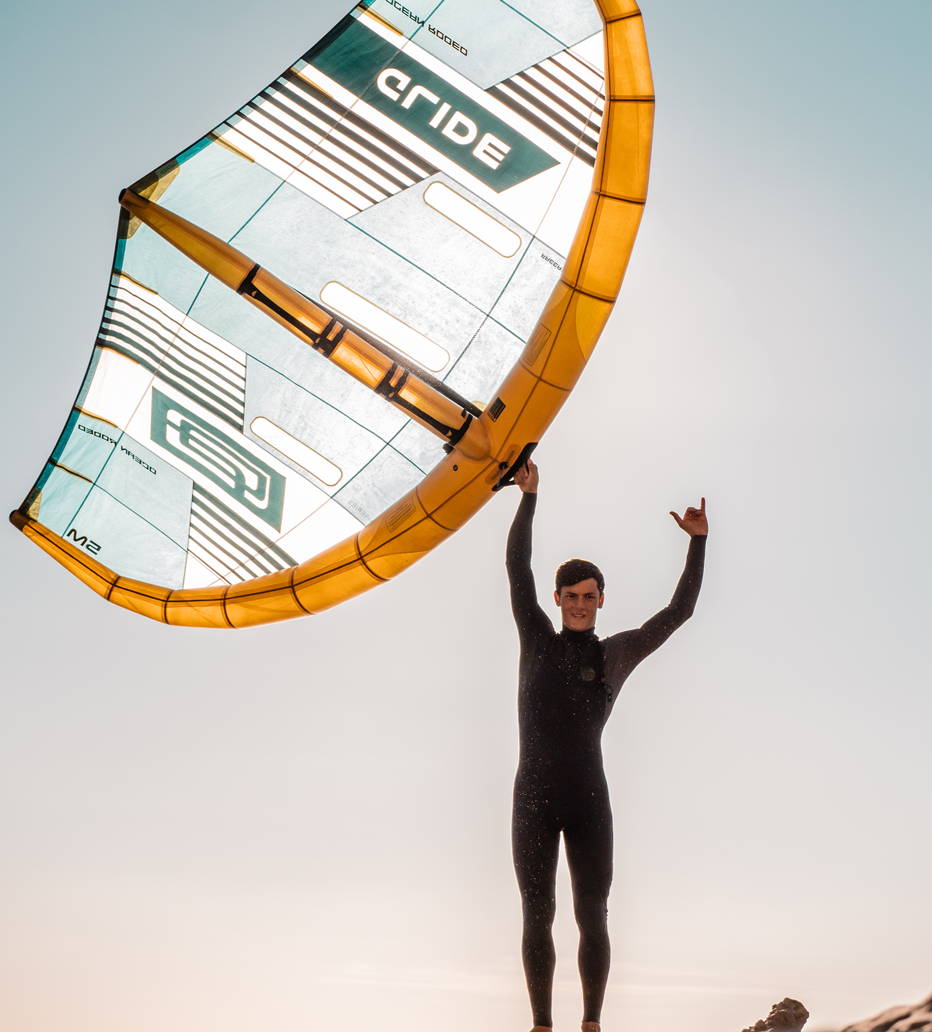
> What are your goals for 2023 and beyond?
I have two main goals to achieve this year which are winning the ANOC World Beach Games in Bali, Indonesia and winning the World Title for the second year in a row by winning as many World Cups as I’m capable of.
> How do you see the sport/discipline of wing foil racing progressing/changing as it continues to develop?
I’m convinced we’ll see a lot of innovations around wing designs and shapes. I also think that the boom will become our weapon of choice when it comes to racing handles. Then the Medal Series format from the IWSA is really captivating and fun. I think it’ll attract more and more viewers as it is interesting for the public to have a final day where “everything” is possible, while remaining fair to the athletes for their hard work during the previous competition days. I hope that wingfoiling will become an Olympic sport in 2028, and if it is not - due to the five year registration period - I’m convinced it’ll go to the Olympics in 2032.
At only 20 years of age, Mathis has reached incredible heights already in the world of Wingfoil racing. In the second part of the series, Mathis takes us through his personal aspirations for the future and shares what it takes if you are keen to up your wingfoiling game. He also gives us an insight into some of the exciting innovations coming up next from Ocean Rodeo.
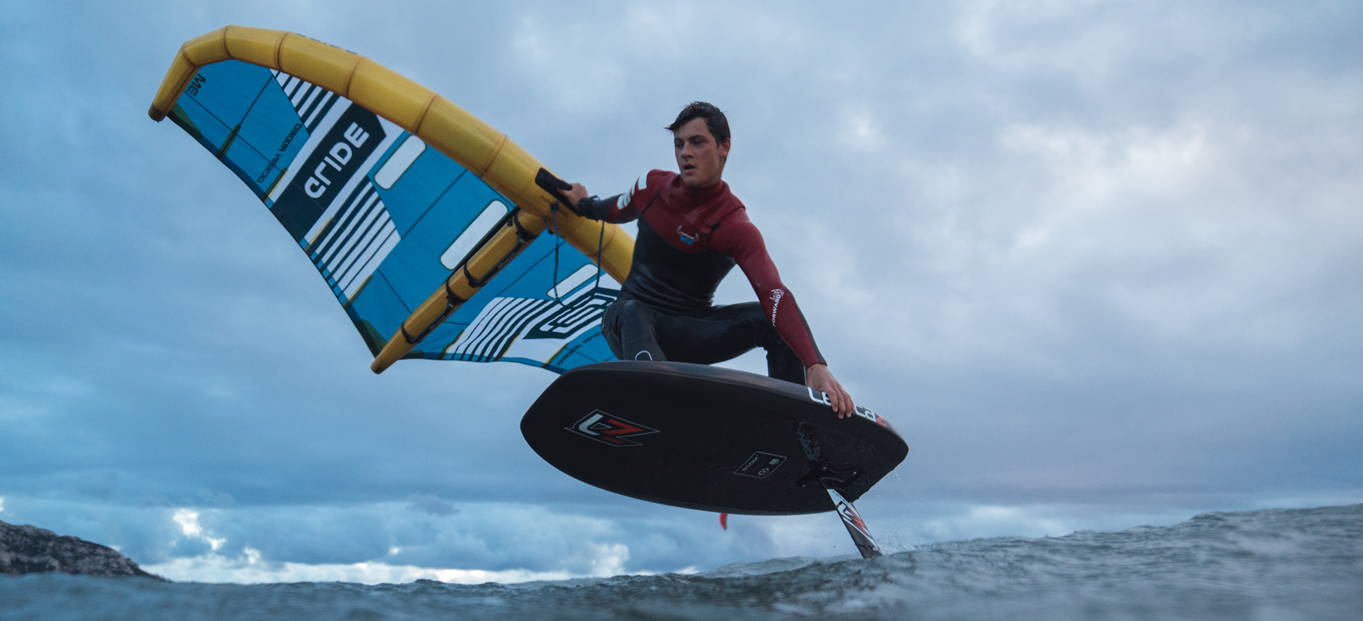
> We hear you're using a special bladder from ALUULA on your struts...what is the difference you’ve noticed?
Since using the ALUULA bladder on my strut, I’ve felt the strut has been much stiffer, which puts more power into my hands. The strut also doesn’t twist when I use harness lines and I’m pulling with all of my weight to accelerate. This is a huge plus when it comes to pumping efficiency.
> You've been testing some early ALUULA canopy. What's your thoughts in terms of speed if the canopy can be made stiffer?
Yes, the new canopy is insanely strong and stiff. I was feeling much more power from the 5m that I tested, and the pumping is now even more efficient. Having a stiffer canopy results in having more power for a wing of the same size. It also allows me to reduce the wing size and so to reduce the leading edge and the drag from that. It directly results in higher speeds and faster acceleration due to less stretch from the canopy. It also helps to avoid the distortions of the canopy created by the wind speed, so it will reduce drag with a cleaner wing profile.
> In terms of use and performance, what do you expect will be the biggest improvements made to winging with new canopy materials, in terms of racing and general all-round wingfoiling?
In my opinion, this will be the new arms race in the coming years, for all the brands to find an efficient canopy material, as it was two years ago for the leading edge and strut materials. So many different materials are already out, but yet again, I’m convinced that ALUULA material for the canopy will be another revolution and the ultimate leader when it comes to stiffness, power, lightness and durability.
For racing, new canopy materials with much more stiffness, and thus power, are gonna help to reduce the wing size, and so lead to slimmer leading edge profiles to reduce drag and to increase the speed. For winging overall, I think that we’ll be able to fly in lighter conditions, to reduce and maybe eliminate the current situation with standard wings where it is possible to fly but impossible to take off in light wind conditions.
When did you start winging? Is it easy for everyone to learn and progress in it?
I started winging in October 2020, so less than three years ago. In terms of learning, I’ve seen plenty of different beginner profiles - I’ve seen some friends who have never practiced a water sport in their life able to make their first wing flight after a week of lessons. Having the right equipment helps a lot at the beginning for sure, but when they are well equipped, their giant smile at the end of the session speaks for itself.
Wingfoiling is much safer to learn than kitesurfing because you’ll never be in danger while learning. If you’re drifting too much, you lay on your board, paddle upwind and then you’re out of danger. Winging is also easier to learn than windsurfing, because the sail is so much lighter, so you won’t struggle to get it out of the water every time you fail.
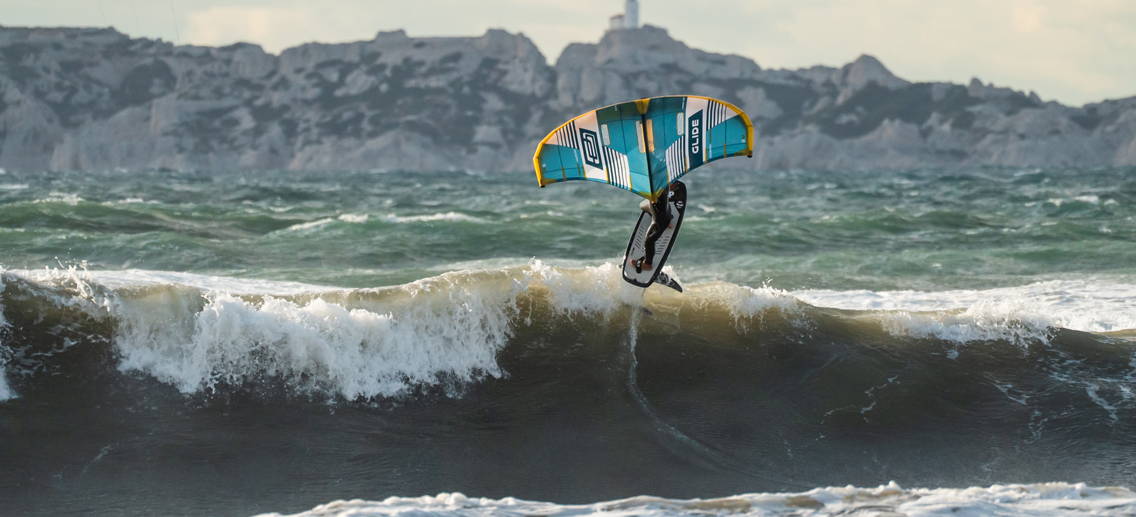
What would be your main advice for anyone just starting out on a wing?
My main advice for wingfoil beginners is to start with some tow in and learn how to fall properly. You have to always let yourself fall in the direction of the board, and not counter the foil by leaning in its opposite direction because this will result in you kissing your frontwing…
Do you think there's an ideal body size for wing racing?
For the moment, there is not an ideal body in winging, but there are some advantages to being tall, because it is possible to put the wing in front and so to capture the maximum amount of wind, and around 80-85kg to press down on the foil efficiently. The only factors which are limiting this weight are the lift and power differences that exist between kites and the wing. In the meantime, being heavier than 85kg in winging would mean having to make big equipment choices because the foil size would not be the same in light, normal, and strong wind conditions. The foil choices would be so hard to decide and to make, except if a coach is on the water and able to change the foil quickly for you. I’m convinced that in the near future we’ll see the same body sizes in winging as we do in windsurf and kitefoil.
> Is it hard to transition from riding in waves to racing?
The transition is always so hard for me because I don’t experience the same level of adrenaline and stress. While racing, I’m used to this feeling of speed and stress before starting, but for riding waves, I’m still discovering how to handle it. When there are a lot of waves, I cannot wait and I want to jump in the water instantly to enjoy the swell, because I know that I’ll have a ton of fun while riding the waves. This feeling is present for me in the racing discipline but in a softer way, because I love to be fast and compete with my friends to see who will be the fastest. But I’m able to handle my excitement because I’m so used to it, whereas riding waves is still something I do less frequently.
> What’s your physical training like off the water?
I’m in Lyon five days a week for my studies and I can not wingfoil there, so to blow off some steam, I train almost everyday at the gym. I usually do a lot of cardio and practice weightlifting, targeting my forearms and legs since they're the most used muscles during races.
> How do you prepare before a race start?
I’m the type of person who has a lot of set rituals to destress before racing. I always go out on the water with my camel bag, to take sips of water between my warm-ups. I begin my analysis with an overall view of the competition area by taking in the surrounding coasts, the wind effects and how the start line is set. Then, I’ll choose a side area that seems interesting for the coming race, and I’ll scope it out by going on this side in a straight line towards the area.
If the buoys are already set, I’ll round them to identify the points of sail at the same time. Then, on my way back to the committee boat, I’ll pump exactly like I’ll be in a race, while making a lot of manoeuvers to work on my balance and to prepare my legs for the upcoming race. When I arrive at the committee boat, I take one or two sips of water before giving my camel bag to my coach, and often screw one or two screws of my foil if needed. Then, I dry my wing by pumping a little bit and staying on the foil before the race starts.
> What’s been your favourite race so far?
My favourite race event was definitely the Jericoacoara World Cup last December.The vibes and the conditions were incredible throughout the whole event, and winning the World Cup and the World Title was the icing on the cake.
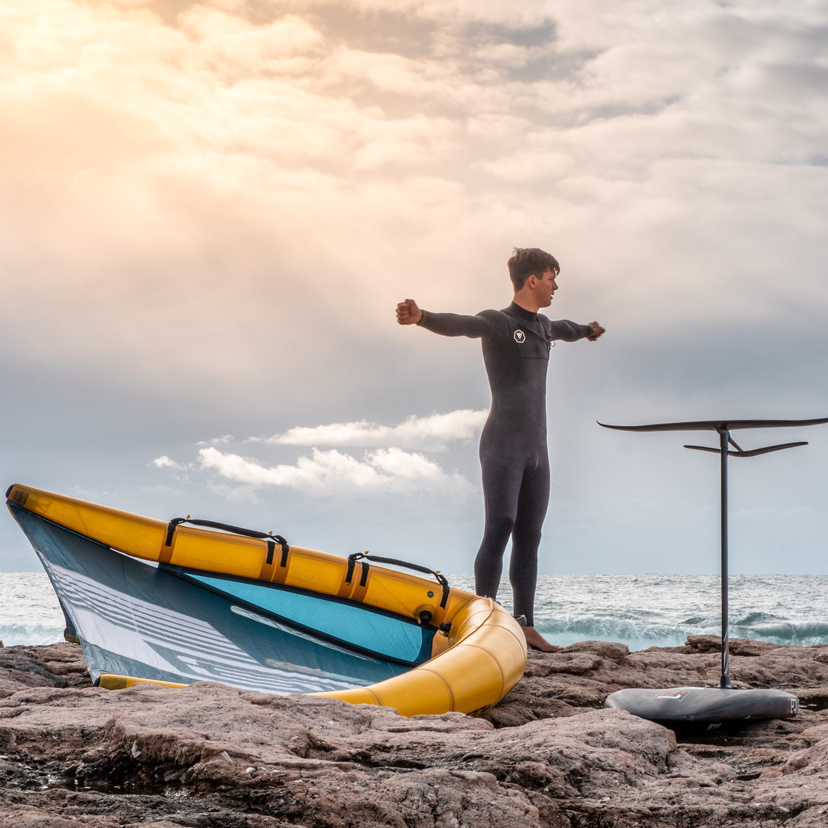

> What are your goals for 2023 and beyond?
I have two main goals to achieve this year which are winning the ANOC World Beach Games in Bali, Indonesia and winning the World Title for the second year in a row by winning as many World Cups as I’m capable of.
> How do you see the sport/discipline of wing foil racing progressing/changing as it continues to develop?
I’m convinced we’ll see a lot of innovations around wing designs and shapes. I also think that the boom will become our weapon of choice when it comes to racing handles. Then the Medal Series format from the IWSA is really captivating and fun. I think it’ll attract more and more viewers as it is interesting for the public to have a final day where “everything” is possible, while remaining fair to the athletes for their hard work during the previous competition days. I hope that wingfoiling will become an Olympic sport in 2028, and if it is not - due to the five year registration period - I’m convinced it’ll go to the Olympics in 2032.
World Champion’s weapon of choice
the Glide A-Series
Experience unparalleled performance in all wind conditions with the World Champion’s weapon of choice – the Glide A-Series. Featuring a full ALUULA airframe, the Glide A-Series is 40% lighter and 2x stiffer and stronger than a comparable Dacron based wing.
Available in sizes 2.5 to 7m.


